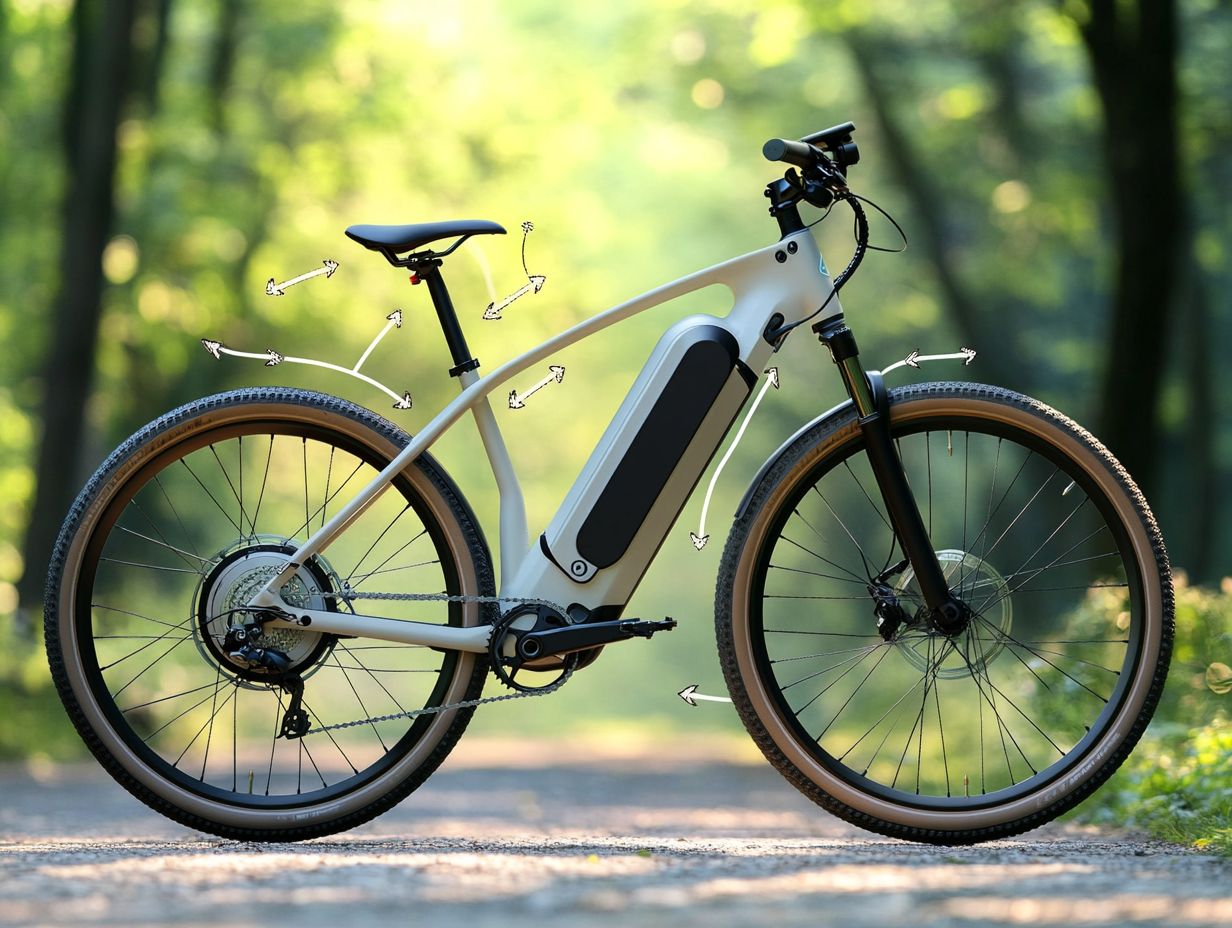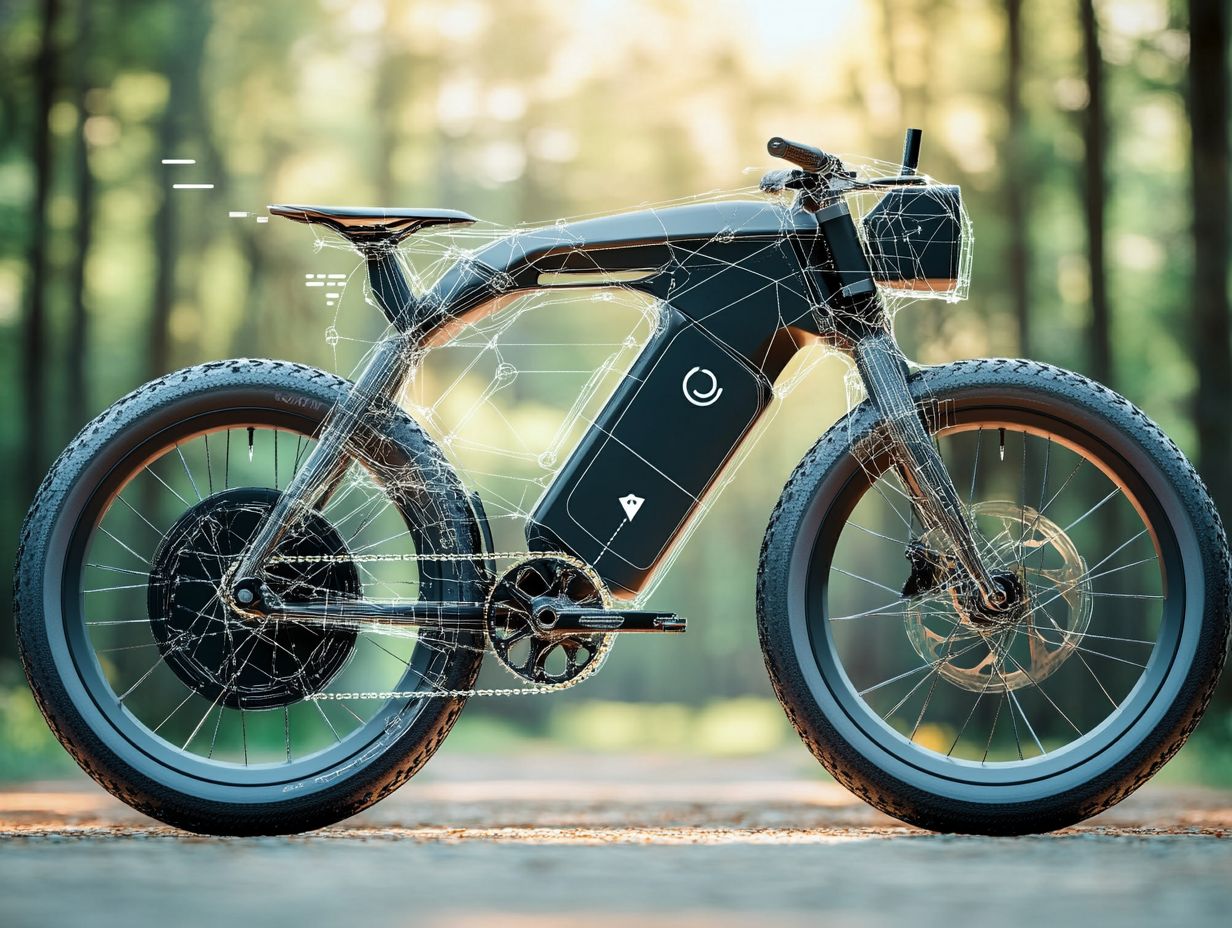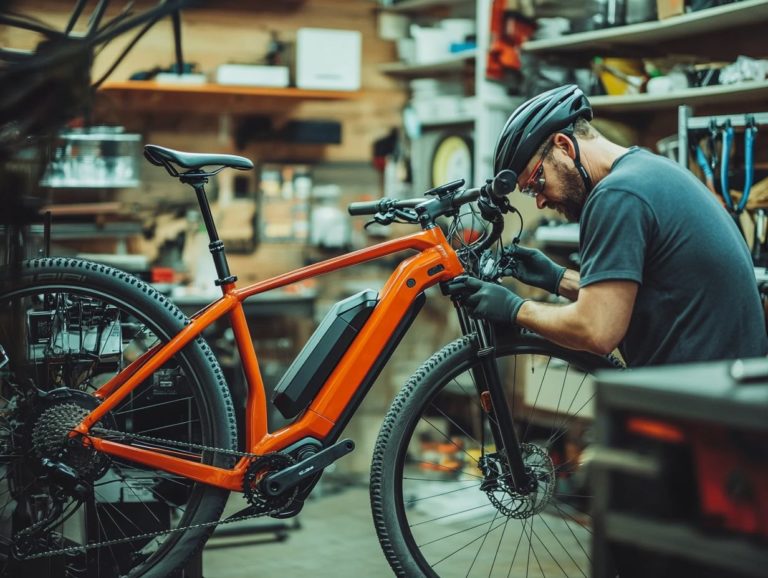What is the Weight Distribution on an E-Bike?
E-bike and electric bikes are revolutionizing your cycling experience, elegantly merging the excitement of traditional biking with the advantages of electric power.
One essential factor that often slips under the radar is weight distribution. Recognizing how weight impacts your ride can significantly elevate your handling, performance, and overall comfort.
This article delves into the nuances of weight distribution on e-bikes, examining the various factors that influence it and providing you with practical tips to achieve optimal balance. It will also address common misconceptions, empowering you to ride both smarter and safer.
Contents
- Key Takeaways:
- Understanding E-Bikes
- Weight Distribution on E-Bikes
- How to Achieve Proper Weight Distribution on an E-Bike
- Benefits of Proper Weight Distribution on E-Bikes
- Common Misconceptions about Weight Distribution on E-Bikes
- Frequently Asked Questions
- What is the Weight Distribution on an E-Bike?
- Why is Weight Distribution Important on an E-Bike?
- How Does Weight Distribution Affect the Handling of an E-Bike?
- What is the Ideal Weight Distribution for an E-Bike?
- How Can I Adjust the Weight Distribution on My E-Bike?
- Does the Weight Distribution on an E-Bike Change When Carrying a Load?
Key Takeaways:

- Proper weight distribution is crucial for optimal performance and handling on an e-bike.
- Adjusting components such as battery placement and tire pressure can help achieve proper weight distribution.
- Proper weight distribution on an e-bike can also reduce strain on parts and components, improving their longevity.
Understanding E-Bikes
Understanding e-bikes is crucial for anyone contemplating the shift to electric cycling, as they seamlessly merge cutting-edge technology with the classic joys of cycling.
E-bikes, or electric bicycles, come equipped with batteries and motors that deliver varying degrees of help while pedaling, catering to a wide range of cycling needs.
This guide is designed to delve into the essential concepts of electric bikes, their components, and their influence on the cycling landscape, giving you the power to make well-informed decisions about your cycling adventures.
What is an E-Bike?
An e-bike, or electric bike, is essentially a bicycle elevated by an electric motor and battery, offering help while pedaling that transforms your cycling experience.
This cutting-edge technology enables you to pedal with far less effort, making those steep hills or longer distances feel like a breeze, so you won t find yourself gasping for air.
The electric motor engages seamlessly, delivering just the right amount of boost based on your input, ensuring that each ride is smooth and enjoyable. The battery plays a crucial role it powers the motor and determines the bike’s range and performance.
You can select from a variety of e-bike types such as city bikes, mountain bikes, and folding models each meticulously designed to meet your unique riding needs.
With enhanced performance, these bikes not only elevate your cycling experience but also promote a more sustainable mode of transportation.
Weight Distribution on E-Bikes
Weight distribution on e-bikes is essential for elevating your riding experience, directly impacting stability, handling, and overall bike performance.
The positioning of the battery and motor whether it is a mid-drive (motor located near the pedals) or a hub (motor located in the wheel) greatly affects how weight is balanced across the frame.
When you achieve proper weight distribution, you enhance your cycling experience by boosting ride stability and maneuverability.
Therefore, it’s crucial for e-bike users like you to grasp this aspect to ensure optimal performance and satisfaction on every ride.
Factors Affecting Weight Distribution
Several factors influence weight distribution on your e-bike, including where the battery is positioned, the weight of the motor, and the overall design of the bike frame.
The materials used in crafting the bike frame significantly impact how weight is managed. For example, aluminum frames are both lightweight and durable, making them a favored option among riders.
On the other hand, carbon fiber frames offer exceptional strength and are even lighter, enhancing your maneuverability.
The geometry and design of these frames are just as important; a lower center of gravity boosts stability, particularly when you re navigating turns.
Additionally, the bike’s capacity how much weight it can handle without sacrificing performance directly influences your ride quality.
By thoughtfully adjusting these elements, manufacturers can optimize weight distribution, leading to a more responsive and enjoyable riding experience for you.
Don t miss out on the opportunity to enhance your ride! Explore your local bike shop today and experience the thrill of e-bikes firsthand!
Importance of Proper Weight Distribution

Proper weight distribution is vital for your e-bike’s handling and performance. It directly impacts ride stability and your overall experience.
When you achieve an even weight distribution across the frame, it allows for better cornering and smoother acceleration. This balance gives you the power to navigate tight turns with confidence and minimizes strain on individual components. For more insights on how weight affects performance, check out the impact of weight on electric bicycle performance, ultimately extending the lifespan of crucial parts like tires and brakes.
Accessories such as luggage racks, handlebar bags, and frame packs can significantly contribute to this balance. By strategically placing these items, you can optimize your e-bike’s performance and enjoy a more pleasurable and efficient cycling experience.
How to Achieve Proper Weight Distribution on an E-Bike
To achieve the right weight distribution, fine-tune your bike’s various components. This creates a balanced and responsive ride.
Adjusting Components for Optimal Balance
Adjust elements like battery weight and motor placement for optimal balance. For instance, lowering the battery can enhance stability during sharp turns and descents.
Ensuring that the motor is centrally located helps distribute weight evenly across the bike, minimizing the risk of tipping during aggressive maneuvers.
You might also consider using lighter materials for accessories and components, which further contributes to a well-distributed load.
When you make these adjustments, your e-bike will not only perform better on flat terrains but will also become more agile and responsive on climbs or rugged trails, ultimately boosting your confidence and comfort as a rider.
Benefits of Proper Weight Distribution on E-Bikes
Proper weight distribution has many advantages. You ll enjoy better handling, enhanced performance, and reduced strain on bike parts.
Improved Handling and Performance
Good weight distribution allows for a more exhilarating ride. It makes navigating sharp turns and uneven surfaces much easier.
During downhill descents, balanced weight enhances stability, keeping the front wheel firmly planted and preventing any loss of control.
When tackling steep hills, maintaining your weight on the rear wheel offers better traction and significantly reduces the chance of slipping. On more technical trails, especially those strewn with roots and rocks, mastering your weight distribution enables you to shift your center of gravity effortlessly. This allows you to maneuver around obstacles with finesse and agility.
Reduced Strain on Parts and Components

Proper weight distribution significantly reduces strain on various parts. It boosts performance and extends the lifespan of your e-bike.
When you ensure that the weight is evenly distributed across the frame especially around critical components like the battery and motor you can expect less wear and tear.
This balanced load not only stabilizes your e-bike during rides but also minimizes vibrations that might lead to early breakdown.
By maintaining this equilibrium, you’ll find that the frequency of maintenance checks can be reduced since less stress translates to fewer adjustments and replacements. Get ready to enjoy a super reliable cycling experience that lasts!
Common Misconceptions about Weight Distribution on E-Bikes
Numerous misconceptions surround weight distribution on e-bikes, which can easily mislead new riders. Understanding how weight affects your cycling needs and overall riding experience is essential for making the most of your e-bike journey.
Debunking Myths and Clarifying Facts
Debunk myths about weight distribution on e-bikes to make informed decisions that can improve your ride. You might think that achieving equal weight distribution is the only way to ensure optimal stability, but that s not necessarily true. In reality, knowing how to adjust your weight especially when carrying cargo or tackling uphill climbs can greatly enhance your handling and control.
Misunderstandings about stiff frames leading to discomfort may discourage you from riding. However, a well-designed bike is built to accommodate various weight distributions, providing improved comfort and efficiency. By gaining accurate insights into how weight impacts performance, you can elevate your riding skills and enjoy a more fulfilling and safer journey across diverse terrains.
Frequently Asked Questions
What is the Weight Distribution on an E-Bike?
The weight distribution on an E-Bike refers to how the weight is spread between the front and rear wheels. It plays a big role in how your bike handles and stays stable.
Why is Weight Distribution Important on an E-Bike?

Weight distribution is important on an E-Bike because it impacts the bike’s performance and handling. Proper weight distribution can lead to better stability, cornering, and overall control.
How Does Weight Distribution Affect the Handling of an E-Bike?
Weight distribution affects handling by shifting the center of gravity. An unbalanced weight distribution can make the bike feel heavy and hard to maneuver. In contrast, a well-distributed weight can make the bike feel light and agile.
What is the Ideal Weight Distribution for an E-Bike?
The ideal weight distribution for an E-Bike varies based on your riding style and preferences. A general rule of thumb is to aim for 60% of the weight on the rear wheel and 40% on the front wheel for optimal handling and stability.
How Can I Adjust the Weight Distribution on My E-Bike?
You can adjust the weight distribution on your E-Bike by moving items like water bottles, bags, or accessories from the front to the back. You can easily shift your body position to boost control and stability!
Does the Weight Distribution on an E-Bike Change When Carrying a Load?
Yes, the weight distribution on an E-Bike can change when carrying a load. It s important to properly distribute the weight of the load to maintain stability and control. Many E-Bikes come with racks or baskets designed to carry extra weight while maintaining proper weight distribution.
Experiment with your E-Bike setup today for a smoother ride!






